A World of Eriocaulon
by Bernd Marks
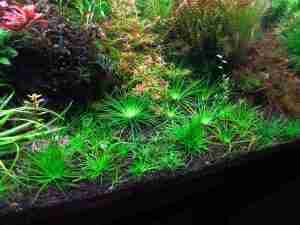 Unfortunately Eriocaulons are still a marginal phenomenon in the hobby, and they really don’t deserve this status. For almost 2 years I have kept E. shiga, E. sieboldianum, E. polaris, E. sulawesi sp, and E. goias. In the course of time I have made the additions to include: Needle leaf, Feather duster, bushy green, Malaytor, Ha’Ra, Vietnam and parkeri. Currently some new babies are also growing from Parviflorum, Black ball, Heimesilatama and more.
Unfortunately Eriocaulons are still a marginal phenomenon in the hobby, and they really don’t deserve this status. For almost 2 years I have kept E. shiga, E. sieboldianum, E. polaris, E. sulawesi sp, and E. goias. In the course of time I have made the additions to include: Needle leaf, Feather duster, bushy green, Malaytor, Ha’Ra, Vietnam and parkeri. Currently some new babies are also growing from Parviflorum, Black ball, Heimesilatama and more.
My eriocaulons tanks are exclusively soft water with a maximum kh of 2. For six months I can also use my tap water for it. Only magnesium do I have to add to make my plants happy.
Nutrients are administered regularly and I do not aspire particularly to have overly high values. Nitrates are approximately 10 mg / l and PO4 in small amounts are sufficient. With Fetrilon and a complete fertilizer, the regimen of my fertilization is completed.
I won’t be going into detail or dwell on the naming of the eriocaulons. Erios are like Bucephalandra, even with the named Erios, if something is amiss I still use the name name from under which I got it.
Eriocaulon sp Sulawesi
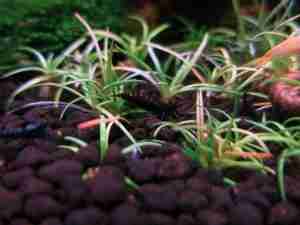
Short story about this form is it was once imported by two brothers but it died out and was lost to the hobby. That which is available to collectors now, was years ago brought in through Italy from Asia and imported under the same designation. The few existing photos of the original sp sulawesi however suggest that they are different plants.
Maximum height is 3 cm, it is hardy permanently submerged and good at lawn making. It is though, slow growing. Propagation is by adventurous runners and seed would also be possible as an occasional flowering appears.
Eriocaulon Shiga and Sieboldianum

These two I would like to deal with together as they are very similar. Max diameter is 8-10cm and they are hardy as permanently submerged. In both of these there is no submerged flowering! An important difference to cinerum, sp and Polaris is that there is not flowering in submerged shiga and sieboldianum. The round stature can sometimes be disturbed by their numerous side shoots. However, therefrom they always produce new plantlets.
Shiga and sieboldianum begin at a certain size (about 5cm) to differ from that of sieboldianum as the blade tips are curved downward. Moreover sieboldianum is colored slightly darker. Depending on the conditions submerged, it is possible that sieboldianum temporarily sets upwards its leaf tips. Shiga, however, has never sent its leaf tips upward and it has a little fresher green.
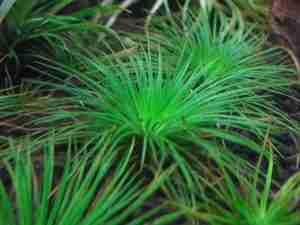
Overall sieboldianum is somewhat less demanding than shiga and some grew quite joyfully. When moving into a new tank its leaves die from the outside toward the inside. However, new leaves are soon growing out of the middle
Eriocaulon australia I have rejected because it was not possible to distinguish them from the Shiga. It is supposed to be possible for very large plants, since the blade tips are to hang somewhat in Australia. Whether I will try that again is not clear.
Eriocaulon Polaris

Maximum diameter is 10-12 cm and has darker leaves than shiga and like a hedgehog has erected leaves that stand. The leaves are thicker and more robust than what is found in shiga and sieboldianum.
Unfortunately polaris doesn’t grow permanently under water and will die after some time. It tends to push upward a flower formation and from there it is super exciting. The Polaris provides no new foliar growth and only pushes up the stalk. But that is not the end. There is a possibility that the buds grow adventitiously and create new plants. If polaris secures its health you should allow it to grow on its own. Cut the new plant fast and share the plant can be successful. The formation of side shoots is rare with her, and I’ve experienced it only once. Anything is possible, and this is why the Erios fascinate me.
Eriocaulon Needle Leaf and Feather Duster

Although they can be in appearance clearly different, they have many similarities to each other. Your grassy look is somewhat reminiscent of Helferis Cyperus. Needle leaf has of the two the most significantly broader leaves, about 5mm at the widest point.
Feather duster brings it more narrow with a width of about 2-3mm. Needle leaf also achieves a submerged height of 50cm and can reach effortlessly to the surface. Feather duster attains a slightly shorter height of around 40 cm.
The proliferation of both of these plants is by abundant side shoots from the rhizome so that beautiful new bushes arise . Flowers I had not yet experienced in my plants. However adventitious growth of a needle leaf, on one stalk grew. An economical and easy representative of Eriocaulon, the growth rate is considerably high for the normally slow rate of growth most Erios make.
Eriocaulon Malaytor and Bushy Green
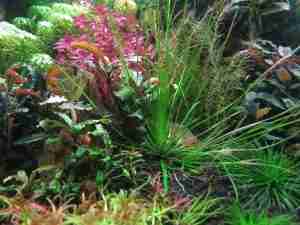
So far I can not see much if any difference so I will summarize both of them here. However beautiful, these Erios demands its rightful place. Currently, I can report a total height of about 20cm. She is always bushy so they are rather something of a solitary planting
Reproduction came forth from runners growing from the rhizome. The Malaytor once pushed up a stalk, where then grew small adventitious plantlets. Simultaneously offshoots grew increasingly from the rhizome. The motherplant died over some several months.
Eriocaulon Parkeri

With the average plant around 6-7 cm, it has a stellate appearance and it is quite a looker in the front area. This Erio counts with me to be the rather easy-care Erios.
Propagation is via independent rhizome division, and is accompanied by the bustle of flowering stems. This new growth can be left as is, or it can be pulled with a little jerk from the plant. It does not matter.
Under extremely good conditions they can actually reach 10 cm, that is for me so far the longest but only once reached that far. Then it also shows beautiful long, light green leaves. Under less favorable housing conditions, the leaves can be short, dark, and resemble a green stinger.
Eriocaulon Vietnam / Taiwan

With these two we have two different names but in my view, they are identical plants. The Vietnam / Taiwan is the easiest and best multiplication of all Erios. I’ve had the height reach almost 12 cm. It is ideal for the foreground, or even a background in a nano setup. The dark green leaves are also circularly arranged, however perhaps irregular. So far, there was no flowering.
Eriocaulon Goias
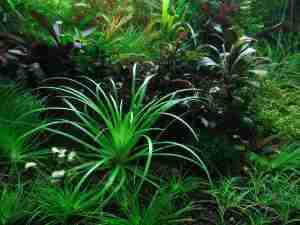
Goias is a jewel among the Eriocaulon. With a height of up to 15 cm and bright green leaves, it is a focal point in any aquarium. The symmetrical design makes it look very orderly. With sufficient light and nutrients along with good water values they are quite possible. Who wants to tease out this jewel should simply offer it everything!
Flowering I have never had with her never, but I know of plants with flower stalks with adventitious plantlets. Multiplication with me so far has only been from the rhizome. However, the mother plant is not dead and I have kept it in my care for about two years.
Conclusion
I have purposely omitted technical terms. This is supposed to be well understood by anyone. These are all my own experiences and observations, but I am for the exchange of ideas with the handful of lovers of Eriocaulons. So now you know my addiction and worst vice: Eriocaulons.
 Biotope One A Study of Flora and Fauna
Biotope One A Study of Flora and Fauna 


